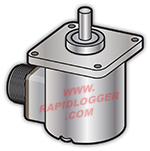During drilling and logging operation depth is a critical parameter measured in the oilfield. Depth of a wireline logging tool, the drilling depth, or the depth of Coiled Tubing in the well are all usually measured by means of a depth encoder.

The depth encoder is usually a small cylindrical device with a shaft on one end. The shaft is generally fixed to a wheel or sprocket axle such that the encoder shaft rotates with the wheel.
Each rotation of the encoder shaft can be accurately measured by means of a perforated disk installed inside the encoder. A small light beam shines on one side of the perforated disk. As the disk rotates a series of light and dark pulses appear on the other side of the disk as the perforations pass in front of the light. The pulses are sensed by a light sensor and counted to determine the exact total and fractional rotations of the shaft. In this manner an encoder utilizes two light sensor that are set apart from each. The second light sensor allows the encoder to also sense the direction of rotation of the disk. Depth encoder signals can be input directly in to the Rapidlogger System, recorded, displayed, and reported. The Rapidlogger system can also easily calculate speed from the depth values.